Space tunnels and iron on the head, or why do we need the Vostochny spaceport

The other day I was asked to advise infographics RIA Novosti, dedicated to the first launch from the Vostochny cosmodrome. And there will be one major simplification due to the limitations of the format of the material. In fact, we do not need the Vostochny cosmodrome due to the fact that the majority of civilian launches occur from the Baikonur cosmodrome. But in order to explain why we need it, we will have to tell why the orbit of a spacecraft can be compared with a tunnel, and also explain what falls behind the “iron” from the sky and to which it falls.
Tunnel in the sky
The physics of the orbital motion is completely non-intuitive. It is rather the opposite of what an ordinary person imagines. And even good films, which seem to be striving for realism, give a completely wrong idea of how satellites and spacecraft fly. Remember the "Gravity", which famously flew from the "Hubble" to the ISS, and then to the Chinese station? Even if we discard the difference in the height of the orbits, one parameter of the orbital motion kills even the slightest chance of such flights. This parameter is called the orbit inclination.
The inclination of the orbit is the angle between the orbital plane of the satellite and the equatorial plane (for the Earth’s satellite)
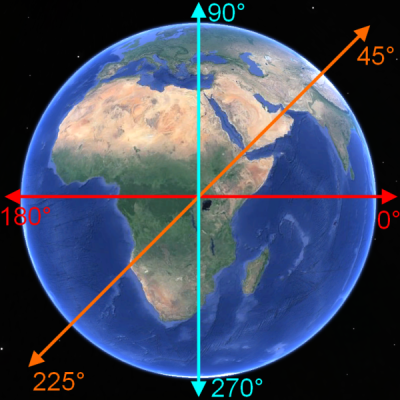
For example, for the case of "Gravity" the picture would be:

And the fact that the orbital planes do not coincide at all - it does not matter. The real trouble is that for a low circular orbit (and the Hubble, the ISS, the Tiangun and the mass of other satellites is a low circular orbit) the change in inclination is very expensive. In order to "rotate" the orbit by 45 °, we will have to change our speed by about 8 km / s, as much as we needed to go into orbit. And the change in speed is a waste of fuel and a discharge of steps. That is, if a rocket weighing 300 tons puts 7 tons into orbit, then after changing the inclination by 45 ° only 150 kilograms will remain. In fact, each orbiter flies inside an invisible tunnel, the diameter of which depends on its ability to change its speed. Therefore, when launching satellites, they are trying to bring them right to the desired mood.
Spur roads
And what is the inclination used for existing orbiters? Now there are a lot of satellites in Earth orbit:

If you look closely, you can see that there are more satellites in some orbits. Here is a picture showing the motion of satellites relative to the Earth:

Geostationary orbit(green). This is a circular orbit with an altitude of 36,000 km and an inclination of 0 °. The satellite on it is located above one point on the earth's surface, so the correct geostationary orbit is indicated by a green point in the picture. Green loops are faulty satellites or those that have run out of fuel. The geostationary orbit is under the disturbing influence of the moon, and you need to spend fuel just to stay in place. Telecommunication satellites that make a profit live in this orbit, so it is difficult to find empty seats on it.
GLONAS / GPS orbits (blue and red). These orbits have an altitude of about 20,000 kilometers and an inclination in the region of 60 °. As the name implies, they are navigation satellites.
Polar orbits(yellow). These orbits have an inclination in the region of 90 ° and a height of usually no more than 1000 km. In this case, the satellite will fly over the poles every turn and will see the entire territory of the Earth. A separate subspecies of such orbits are solar-synchronous orbits with an altitude of 600–800 km and an inclination of 98 °, in which the satellites fly over different parts of the Earth at approximately the same local time. These orbits are in demand for meteorological, cartographic and reconnaissance satellites.
In addition, it should be noted the orbit of the ISS with a height of 450 km and an inclination of 51.6 °.
Heartless geography
Well, well, we figured out the moods, the reader will say. And where does the spaceport? The fact is that there is such an unpleasant physical law:
The initial inclination of the orbit cannot be less than the width of the cosmodrome.
Why is that? Everything becomes clearer if we draw the satellite trajectory on the map of the Earth:

If we, starting from Baikonur, begin to accelerate to the east, then we get an orbit with the inclination of the latitude of Baikonur, 45 ° (red). If we start to accelerate to the northeast, the northernmost point of the orbit will be north of Baikonur, that is, the inclination will be greater (yellow). If we try to cheat and start to accelerate to the southeast, then the resulting orbit will still have the most northern point north of Baikonur and, again, a larger inclination (blue).

But such an orbit is impossible physically, because it does not pass through the center of mass of the Earth. More precisely, it is impossible to fly with the engine off. You will be able to be in such an orbit for some time with the engine turned on, but the fuel will end very quickly.
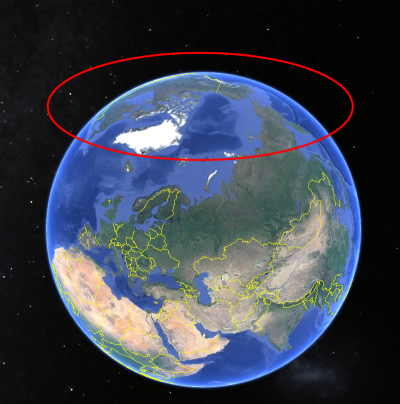
Thus, if we want to launch satellites into a geostationary orbit not from the equator, we need to somehow reset the orbit inclination, consuming the fuel. It is these costs that explain why the same Soyuz-2.1a rocket successfully brings satellites into geostationary orbit from the Kourou cosmodrome near the equator, but is not used for these tasks from Baikonur.
Russia is a northern country. And if you can launch satellites from Plesetsk, which is located at latitude 63 °, into polar orbits and GLONASS orbits, then for a geosynchronous orbit, the south the spaceport is located, the better. And here the second problem comes into force - not any territory is suitable for a cosmodrome.
Kumpol level
When launching a satellite, all modern rockets dump waste stages and head fairings that fall to Earth. If the crash site is in another country, you have to negotiate with this country for each launch. Therefore, for example, the minimum inclination of the Baikonur cosmodrome is not 45 °, but 51 °, because otherwise the second stage will fall to China:
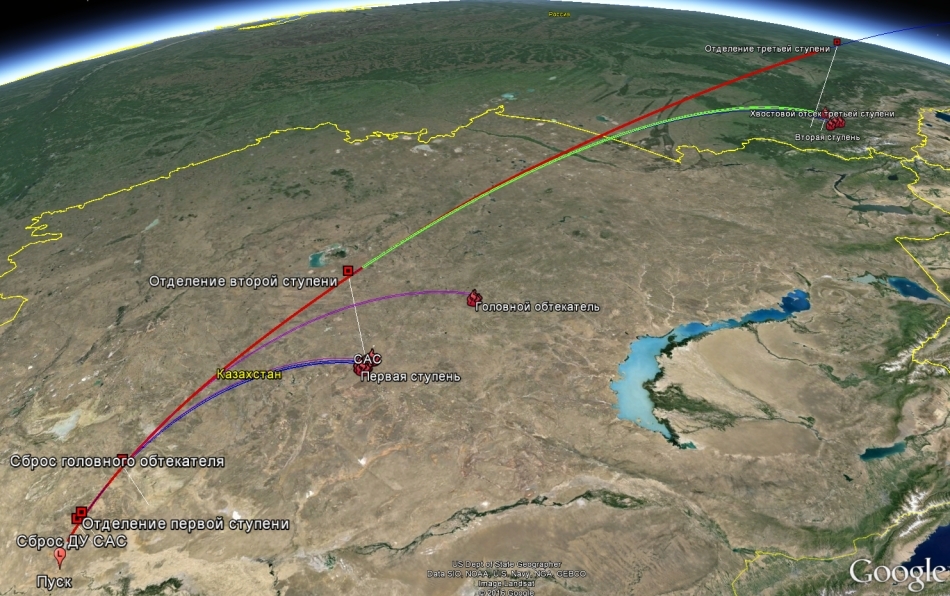
And at the place of the first stage fall, you have to agree with Kazakhstan and pay for the use of these areas. Sometimes there are problems, and the launch of satellites is postponed. Fall areas have to alienate rather big ones:

And in the European part of Russia there are no good places for the cosmodrome. I played with the cards, in the Caucasus, you can dodge and try to run from the area of Mozdok, but even then you will have to try to prevent the second steps from falling into Kazakhstan. If you launch a rocket from the Crimea, the first stage will fall into populated areas near Rostov-on-Don, and the second stage will again strive to fall into Kazakhstan. And this does not take into account the problems with the infrastructure in both variants. Against this background, you will look at the available moods for US spaceports and regret the heartlessness of physics with geography.
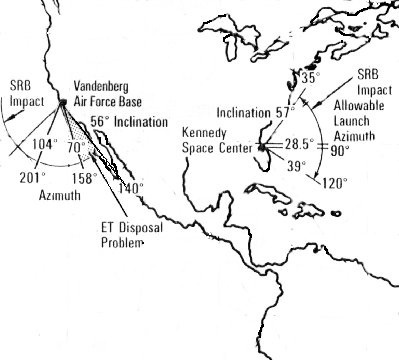
But we also have the east coast. And, if we place the cosmodrome there, then it will be possible to find deaf areas for the fall of spent steps for the most popular moods: 51.6 ° (on the ISS and geostationary orbit), 64.8 ° (GLONASS, some Earth sensing satellites), 98 ° (into polar orbit).
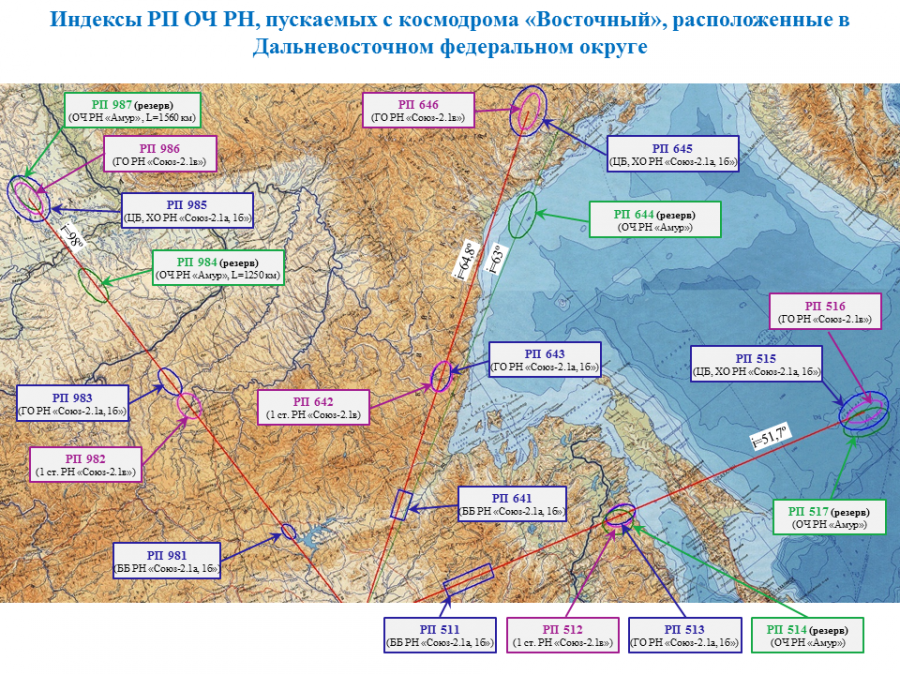
Once again tezisno
The Vostochny space center will give us the opportunity to launch payloads on the geostationary orbit and to the ISS without the need to coordinate these launches with other countries and pay them for using the exclusion areas. It is located in the southern part of the country and provides an initial orbit inclination no worse than Baikonur. The launch complex for the new Angara launch vehicle is not efficient to build at Baikonur (once again, coordination of launches and areas of incidence), but from the East it will provide no less payload.
A pleasant trifle: the new launch complex with a service tower, as in Kourou, will allow launching western payloads, which must be installed on the launch vehicle in an upright position.
The bonus also includes the development of infrastructure, an impetus to the development of the territory, the science city and so on.
UPD: infographics out. Sorry, did not have time to redraw the placement of satellites. Very briefly, after all, we tried to explain what is written here. In my opinion it turned out pretty.
